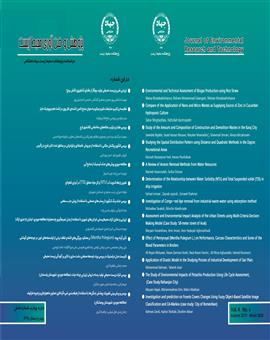ارزیابی فنی و زیست محیطی تولید بیوگاز از بقایای کشاورزی (کلش برنج)
محورهای موضوعی : ارزیابی اثرات زیست محیطیمهسا خدابخشی پور 1 , محسن محمدی گلنگش 2 * , محسن خدابخشی پور 3
1 - دانشگاه گیلان
2 - عضو هیات علمی دانشگاه گیلان
3 - دانشگاه خوزستان
کلید واژه: بیوگاز, ضایعات کشاورزی, کلش برنج, آلودگی,
چکیده مقاله :
انرژی مصرفی در جهان به سرعت در حال افزایش است و انتظار میرود که منابع انرژی غیرقابل تجدید در آینده به پایان برسد. بنابراین، روشهای نوین تولید انرژی در سراسر جهان متداول شده است. بیوگاز یکی از انرژیهای جدید و پاک است که از تخمیر بیهوازی زیست توده تولید میشود. استان گیلان با 238000 هکتار سطح زیر کشت برنج، پتانسیل قابل ملاحظهای برای تولید بیوگاز از بقایای آلی را دارا میباشد. بر این اساس این تحقیق به منظور بررسی تولید بیوگاز از ترکیب کاه و کلش برنج و فضولات دامی به ترتیب با نسبتهای (100-0)، (95-5)، (90-10)، (85-15)، (80-20) در سه تکرار انجام شد. آزمایش در دمای مزوفیلیک با روش هضم بیهوازی درون بطریهای 5/1 لیتری اجرا شد. ارزیابی اقتصادی و زیست محیطی بهمنظور جایگزینی بیوگاز تولیدی در این فرایند با سوخت فسیلی در روستای پونل استان گیلان انجام شد. نتایج نشان داد نسبت 10 درصد کلش بیشترین راندمان تولید بیوگاز را داشته و با جایگزینی بیوگاز 21 درصد در مصرف سوخت فسیلی صرفهجویی خواهد شد. همچنین از انتشار مقدار 14/328 کیلوگرم گاز CO2 در سال به اتمسفر جلوگیری خواهد شد.
Energy consumption is increasing rapidly in the world and it is expected that unrenewable energy sources will expire in the future; therefore, new methods of energy production are becoming more common all over the world. Biogas is one of the new and clean energies, which is produced from anaerobic fermentation of biomass. Guilan province with 238,000 hectares of paddy lands has significant potential for biogas production from organic residues. In this way, this study was carried out to investigate the process of biogas production from the combination of rice straw and animal waste with the ratios of (0-100), (5-95), (10-90), (15-85), (20-80) respectively in three repetitions. The experiment was performed at mesophilic temperature by anaerobic digestion method in the 1/5 lit bottles. An economic and environmental assessment for replacement of biogas produced in this process with fossil fuels was implemented in the village of Pounel in Guilan Province. The results showed that the ratio of 10% of rice straw had the highest biogas production efficiency and by replacing the biogas, 21 percent will save in fossil fuel consumption. It will also prevent the emission of 328.42 kg of CO2 gas into the atmosphere per year.

